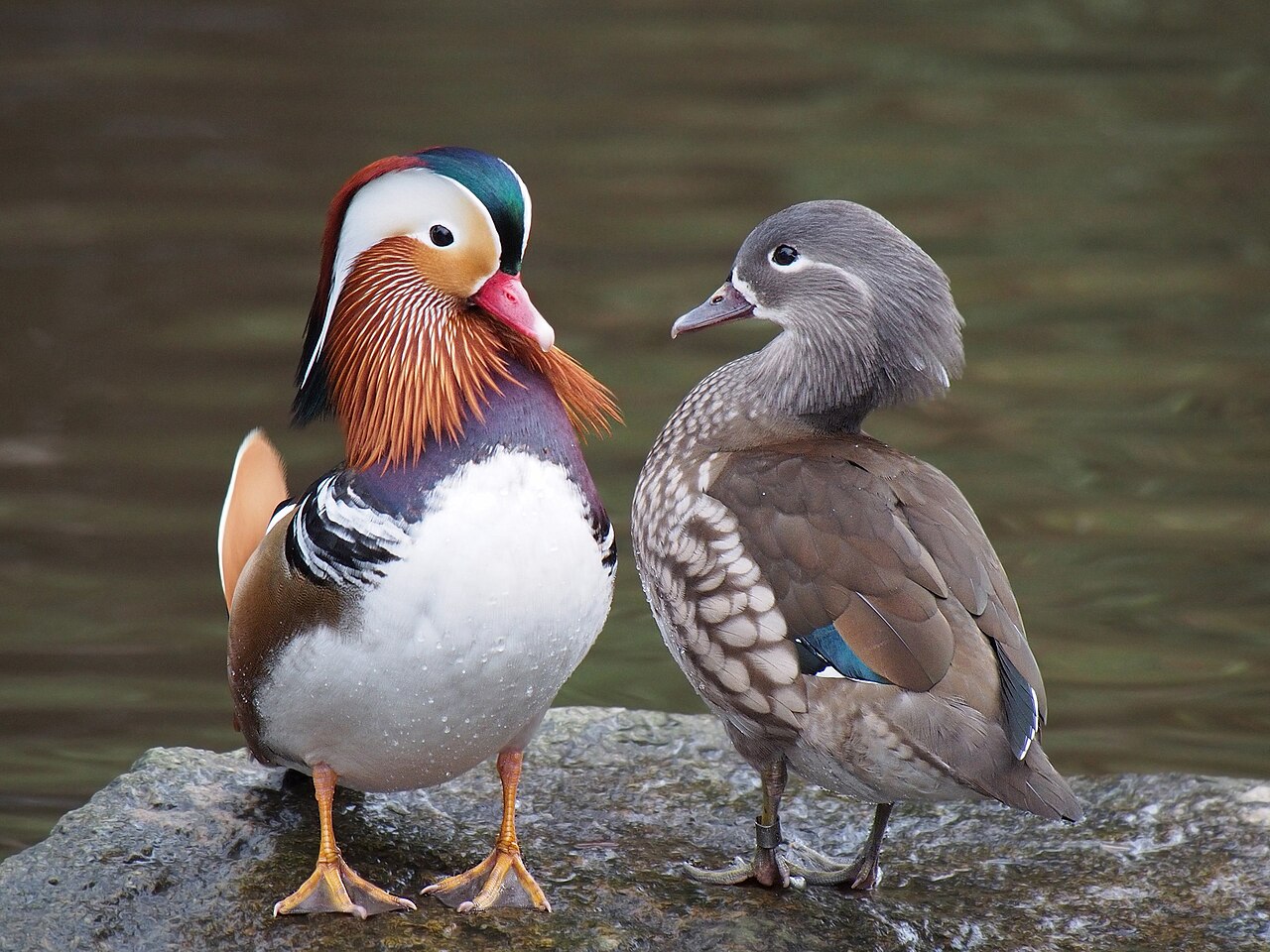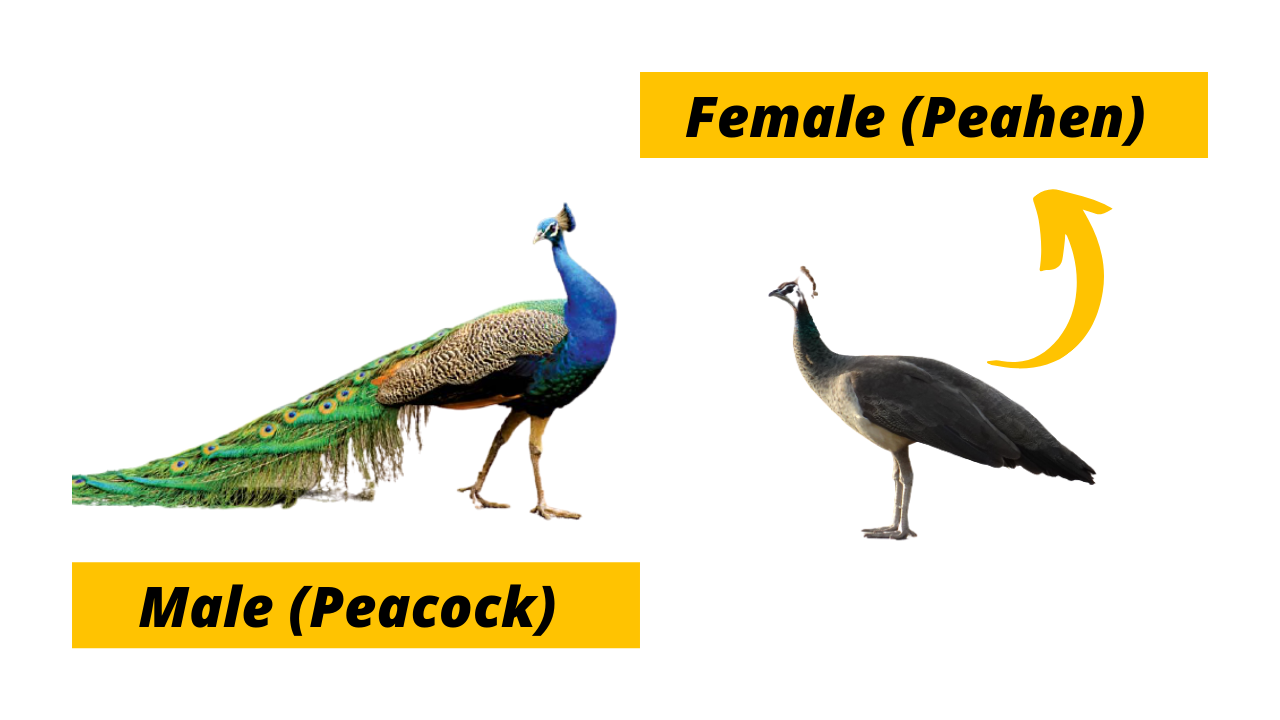In polygamous species, Males are often more colourful and attractive than females. However, in some bird species, the female is more attractive. Birds show a phenomenon called sexual dichromatism, in which both the sexes of the same species are coloured differently. In nature it has been found that in polygamous species in which one of the sexes is more in number (e.g male) and has to compete for a mate is more colourful, while the sex (e.g female) that has to take care of the eggs and chicks is less colourful.

Male Birds Compete with Other Male Birds
In species where the males have to compete with other males for a mate (e.g. paradise flycatcher) the males have brighter colors, longer feathers and are overall more attractive than their female counterparts. Though these bright and colourful features help the male to find his female mate, it also puts the male bird at a risk. His bright colors stand out against simple colours such as a green canopy or brown bark of a tree, and make him more visible to predators. Is having a colourful body to attract a female worth the risk of dying from a predator’s attack?

Theory of Natural Selection
The reason why some male birds are more colourful than females can be explained by the the theory of sexual selection. But first let us understand what is natural selection. Natural selection is often explained by the phrase ‘survival of the fittest’. Those organisms that have favourable traits are able to survive, reproduce and leave their genes with their offspring. Those organisms that have un-favourable traits are unable to survive and reproduce, consequently, their genes die with them. Through natural selection, only those organisms that have favorable traits survive over many generations.
Theory of Sexual Selection
There are some traits that appear to be useful while also serving as a disadvantage. For example, In a duel between two antelope deer to win the chance to mate with the female, the deer with longer horns is more likely to win. If the same two antelope deer happened to be attacked by a cheetah, the deer with shorter horns would be more likely to escape and run away, while the deer with longer horns would probably not be able to escape, as it would difficult to run fast with longer horns, and the horns may get stuck in foliage. This trait of long horns can be dangerous and hence natural selection should have eliminated this trait through the course of evolution, however due to the advantage that this trait provides in leaving more offspring behind, it is not eliminated. The reason why some males birds are more colourful than females can be explained similarly.
Sexual Selection in Birds
In some bird species, there is an abundance of males, and many males have to compete with each other for a single female. Those males which have brighter colours are able to win the female over. In birds, such as a peacock, the dance and display of the feathers to the female of his species, may make him vulnerable to attack. If there are multiple males that are competing for a single female, only the male with a full display and attractive dance will be able to win the female over, mate, and leave behind their genes in the offspring. The other males, who do not, lose their opportunity to pass on their genes, and their genes die with them.

Bright Colours Indicate Good Health
The bright colours of the males also indicate to the female whether the male is healthy and fit. In some species, some of the colours of the feathers are developed by the food that the bird has eaten and this is good indicator to the female, as she would know that the male would be able to provide food to their offspring. Males also use their colours to mark territories and signal to other birds that they have occupied a certain area and are healthy and willing to fight if need be.
Females are more coloured in some species
What female birds are more colorful than males? In bird species such as phalaropes, sandpipers and button quail, where the males take care of the nest and there are many females that compete with each other, the females are more brightly coloured.
Advantages of dull colours in birds
Not having bright colours has a lot of advantages. Females usually take care of the nest, the eggs and the young ones after they hatch. The drag colours help them blend into the environment such as the tree trunk or the branch upon which the nest is perched. The dull colours help them to escape the eyes of the predators. The young ones hatched out of the eggs, irrespective of being male or female, have the same dull colours, The males develop their bright colours only later on in their lives. The young bird is unable to protect himself, and hence this a good protective strategy.
In colder climates, where the overall number of birds is few, males are not as colourful and sometimes even as drag coloured as females. The probability of standing out due to a bright colour against a brown or white background of a snow desert increases their chance of being attacked by a predator greater. The risk here is higher as they might be killed before they get a chance to mate.
Hence, male birds are not always more attractive than females across species. Males birds are more colourful than females in in species where there is male-male competition for a single female.
References
https://www.nature.com/scitable/blog/accumulating-glitches/an_introduction_to_sexual_selection/
Photos, Vector Graphics & Illustrations Credits
By J.M.Garg – Own work, CC BY 3.0, https://commons.wikimedia.org/w/index.php?curid=7509807
By 2010468sanjana – Own work, CC BY-SA 4.0, https://commons.wikimedia.org/w/index.php?curid=103783695
By © Francis C. Franklin / CC-BY-SA-3.0, CC BY-SA 3.0, https://commons.wikimedia.org/w/index.php?curid=31025358
By PAWAN3223 – Own work, CC BY-SA 4.0, https://commons.wikimedia.org/w/index.php?curid=72819132
Get stories like this one in your inbox: Sign up for our email and Subscribe Now To Get The Most Anticipated Edition Of Starry Stories Magazine For Free.
Read more Articles from Life Sciences
1. Read about Start Your Own Fruit Fly Culture at Home
2. Read about the Did You Just Spot a Cheetah a Leopard and a Jaguar
3. Read about the The Secret Lives of Tardigrades
4. Read about the Chlorophyll and Haemoglobin – An Unlikely Connection
5. Read about the What is the True Colour of the Coronavirus?
6. Read about 7 Fascinating Facts About Fruit Flies
About Author
Saunri Dhodi Lobo is pursuing M.Sc in Life Sciences with specialization in Neurobiology. Her interests include writing poetry, going for nature walks and swimming. Currently she is involved in research on Alzheimer’s Disease in fruit flies.
Read all Articles by Saunri Dhodi Lobo


😊👍
Wow! So great. This wonderful thing attracted me to your article. I just know the only reason is attracting female birds. The natural world is so interesting. Hope you write more.
Some birds have bright colors, while others don’t. When I see a brightly colored bird flying around, though, chances are I am seeing a male rather than a female.